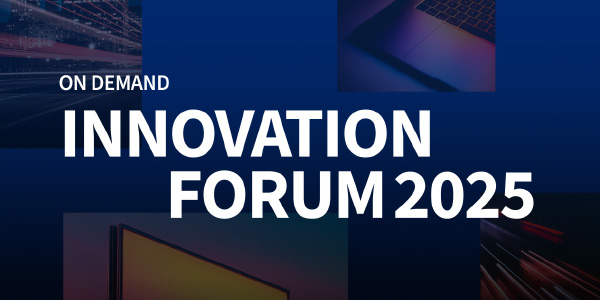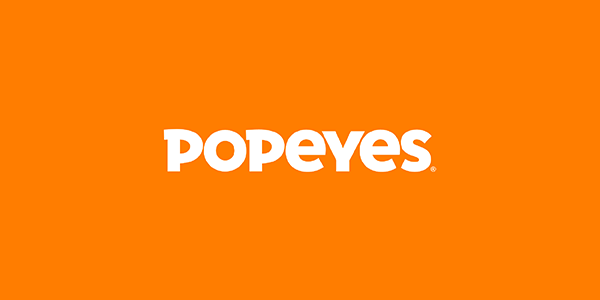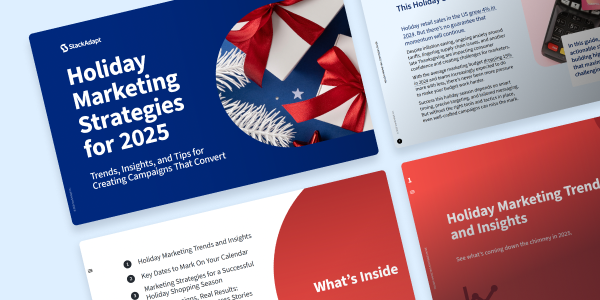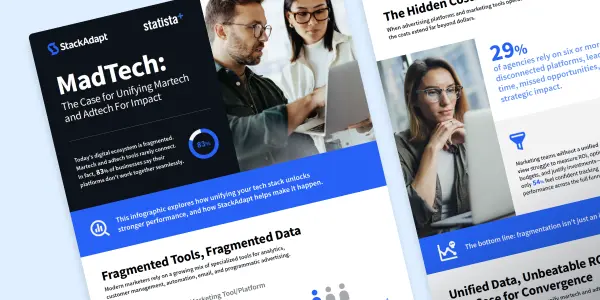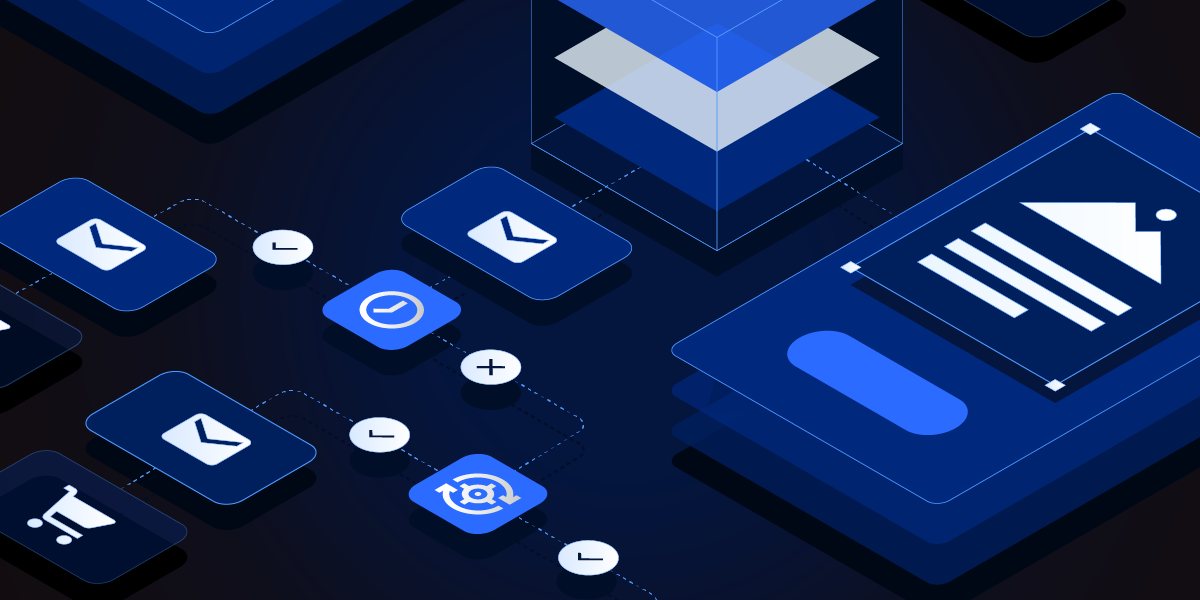The AI Advertising Podcast: S1
Episode 6
Martech Convergence: The Future of Full-Funnel Marketing

About This Episode
The marketing tech stack is undergoing a major shift—from fragmented tools and isolated data to unified platforms that support a full-funnel view of the customer journey. AI is the catalyst, but convergence is the destination.
Vitaly Pecherskiy | CEO and Co-founder, StackAdapt
Ryan Nelsen | CMO, StackAdapt
Winston Zhu | Director of Platform Engineering, StackAdapt
Transcript
Diego Pineda (00:00:00)
For years, marketers have been chasing a dream: a unified view of the customer journey from first impression to final conversion. But reality has looked very different: fragmented tools, siloed data, and disconnected teams. Now, that’s changing. AI is accelerating a major shift in how platforms are built, how media is orchestrated, and how data flows across the entire funnel.
Today, we’re looking at the convergence of martech and adtech, and why it’s one of the most important trends shaping the future of marketing. To help us unpack it, I sat down with two people at the frontlines of this shift: Vitaly Pecherskiy, CEO and co-founder of StackAdapt. And Ryan Nelsen, CMO of StackAdapt. We’ll also hear from Winston Zhu, Director of Platform Engineering at StackAdapt, on how the convergence looks in practice. Let’s get into it.
Podcast Intro (00:00:58)
Welcome to the AI Advertising Podcast, brought to you by StackAdapt. I’m your host, Diego Pineda. Get ready to dive into AI, Ads, and Aha moments.
Diego Pineda (00:01:13)
We started the conversation with a big-picture question: why is convergence accelerating now? Here’s Vitaly on what’s driving the urgency and the opportunity.
Vitaly Pecherskiy (00:01:23)
If we look at what are some of the top concerns in any organization are challenges related to communication, how information travels across teams, silos within technology systems that they use, that the information does not flow logically between all of them. For example, programmatic and marketing, and in our case, the StackAdapt marketing platform essentially tries to accomplish that. It’s the creation of synergies between programmatic and owned distribution channels like email marketing. Currently, these two ecosystems exist completely siloed. Programmatic, it’s often run by agencies, or it could be run by media teams. Owned channels like email is often run in-house by the brand team, or it could be run by a different agency that handles email marketing.
If you look at the systems they’re they’re using to actually execute programmatic campaigns versus email marketing campaigns, they are completely separate. Those systems do not talk to each other. Those teams use different data points, different ways to segment audiences to decide when to target whom. And there’s no universal reporting structures to be able to analyze the the journey across multiple paid and owned channels. And I do think more sophisticated, more like larger enterprises have developed the know-how to unlock insights like this. But if we talk about the vast majority of the businesses, Ithey’re falling behind in in terms of understanding the entire picture of how they use paid and owned channels, how that user journey goes across all of these all these channels all the way to conversion. So to me, it’s incredibly logical that we want to consolidate this under one roof and unlock a ton of synergies between different teams that are experts in their respective disciplines, but allow them to collaborate and execute on their strength within one platform that pulls from the same data, same reporting structures. So we feel very bullish about this this ah convergence of these two ecosystems.
Diego Pineda (00:03:24)
Simplifying the tech stack matters, but the bigger opportunity is gaining a full-funnel view of the customer journey, from first touch to final conversion. Here’s Ryan Nelsen.
Ryan Nelsen (00:03:36)
So, here at Stack Adapt, we’ve traditionally been an adtech company and we’ve been the leading programmatic platform and we’re excited to have new channels that are introduced. We recently introduced email marketing to be able to go from display and native and connected TV and digital out of home and see those ads, experience those ads, go to a shopping cart experience as an commerce example. Maybe you abandon that shopping cart and then a couple hours later or a day later, right within the platform, be able to do a follow-up email to help them convert a checkout. That’s one example of how martech and adtech are coming together across technology to be able to see a customer and have them and follow them throughout the entire customer journey and the funnel.
Diego Pineda (00:04:21)
One of the biggest drivers of convergence right now is data, specifically, first-party data. As cookies disappear and platforms evolve, marketers are realizing that their own data is more valuable than ever, but only if they can activate it effectively.
Ryan Nelsen (00:04:36)
As I look out across the ecosystem of adtech and martekch coming together, I think it all starts with data and understanding your customer, having that first-party data be connected and then being able to be actionable so you can start actioning that data to drive conversions throughout each part of the customer journey. But at the very beginning, it starts with knowing your customer, getting your systems and data right, and then using AI tools now to give prompts to get the right content in front of the right groups at the right time.
Vitaly Pecherskiy (00:05:05)
Let’s start looking at where do you store your customer data and try to unpack how they store customer data, how they currently act on it. And to me, that’s the more the most basic starting point that any marketing team should begin with. You can see how over the last decade plus of evolution of martech, there’s been a number of clear leaders in very fragmented ecosystem, whether it’s marketing automation or customer data platforms or programmatic advertising. None of these systems talk to each other. They all were siloed. As a result, a lot of companies have accumulated a lot of baggage in a lot of these functional areas within marketing teams that are just no longer relevant. If we believe that the future will be in convergence of all these ecosystems to allow faster decision making, to be able to use AI to navigate all these functional areas to unlock sort of better decision making, these systems need to converge in the first place.
The older systems do not talk well to each other, or it requires tremendous amount of resources to actually get them to work. So I would start asking questions around where does your current customer data live and how your individual teams, whether it’s paid media or your email marketing teams, how do they currently utilize this data and how these teams talk to each other to make sure that they’re fully maximizing this data.
Diego Pineda (00:06:34)
That’s exactly what StackAdapt has been working on with their new platform launch, bringing together programmatic and email marketing in one self-serve environment, powered by a central Data Hub.
Vitaly Pecherskiy (00:06:45)
At the core of of our platform is our data hub, which is a slim version of a customer data platform. The idea here is not replacing existing systems. It’s just more giving them a centralized data hub from which they can pull into other use cases, whether it’s paid media or email marketing. It should be an opportunity for consolidation of of of data across across multiple ecosystems. Second, it’s really allowing centralized access point for data to be acted on across paid media and email marketing. And third is just an opportunity for even for people to have a centralized system that they can go into and and force these conversations around like, what are we actually doing together around the same brand, but we just happen to work in different teams or in different agencies, for example. But how do we make sure that what we do is aligned and speaks to the same um the same points, um delivers the message in a cohesive, cohesive, coherent, sequential way that just is valuable to the end user.
Diego Pineda (00:07:54)
We’ve talked about convergence at the strategic level. But what does it look like when it’s put into practice? To help bring this to life, I asked Winston Zhu, Director of Platform Engineering at StackAdapt, to walk us through a real-world example of how first-party data, AI, and cross-channel orchestration can work together.
Winston Zhu (00:08:13)
So for example, if I’m selling a pen using a Shopify store, so based on our integration with Shopify, you know we can use your own CRM data. Once we have everything, there 100,000 users who like this pen with color black. There are 20,000 users who checked out your pen but abandoned them in the carts. There are, you know, X number of amount of users that are interested in not only your pen but also a notebook as well. So once we have this data, how can we use this for advertising, for retargeting, for generating a creative that combines this pen and this notebook, how we can define who is your targeted audience? Maybe, you know, most of the people in the West Coast or in the Washington U.S. are interested in your pen. Then I might be bidding more for the people who are actually in Washington. Then later down the road, how we can track your conversion metrics, how many users see your ads and convert your ads, convert to buying a pen, how many users look at their ads and just save it to the wish list. And then down the road, how we can use this data to optimize your SEO, like search engine optimization, how we can use data to send a you know a marketing email, for example, people who like your pen and didn’t purchase it… I’ll just send them a unique 20% code with AI-generated email content. I might later down send like a programmatic direct mail to your mailbox say, ‘okay, this pen is in a cell in a fancy event near you. Why don’t you come here and you know join the events?’ And then there is like 10% off or something. So all of these from the user’s first party data, there are unlimited number of possibilities you can do. What I said is just like a journey that I painted from my side. But think of a tree or like a flow chart that once you have the first-party data, once you know what user can do, you can do all types of advertisements with the content that generated by AI, routing from the customer data. So it’s hyper-personalized. And later down the road, at certain conditions, you can trigger your marketing campaigns or marketing strategies as well. Do marketing analysis and do like email marketing, do like programmatic mail targeting. So all of these, are once we combine together, you know AI can generate content, AI can use possible customer data, but most importantly, StackAdapt is the master player behind the scene that will let users to do all the full lifecycle journey. Once we have the user customer data, you can do unlimited number of things for advertising and marketing.
Diego Pineda (00:11:07)
This is the future of full-funnel marketing—not just connecting channels, but designing systems that can listen, learn, and respond at every stage.
Winston’s example shows us how convergence, powered by data and AI, moves us beyond isolated tactics into a smarter, more adaptive approach, where everything from bidding to messaging to timing becomes dynamic and personal.
Diego Pineda (00:11:35)
When we talk about AI and marketing, it’s easy to jump straight to the big picture—what the future might look like, what jobs will disappear, or how platforms will evolve. But sometimes, it’s more useful to focus on what’s actually working today—what marketers can implement now, where the friction still is, and what kind of mindset this shift requires.
Ryan Nelsen (00:11:59)
I think some of the platforms if they’re not innovating, they’re getting left behind. And there’s many tools and companies that have been purchased by bigger companies that I think are getting lost in the mix of their broader tech stack and solution offering. So you have increasingly a lot of tech startups that are starting that are a AI built from the ground up and they’re talking with data, they’re integrating with other systems, they have APIs that are connecting seamlessly and that’s powerful. And it’s funny to see sometimes, how big of an impact they’re making with so few employees and they seem to be much bigger than they are. And so you’ll start to have some of these companies that are growing super fast very, very efficient in a revenue per employee standpoint. And what that does is it just allows companies to get more done in less time, make a bigger impact. There was a note the CEO from Shopify that kind of made its rounds on X where he’s basically asking his employees to ask the question, can this be done with AI before opening up that headcount and I think we’re going to see a whole lot more about it. He was more bold than most I think CEOs in saying that. But I thought it was just interesting to that narrative and that conversation starting to happen more and more.
Diego Pineda (00:13:15)
And that reality is starting to divide the field. According to Ryan, there’s a clear fork in the road: marketers who use AI to multiply their impact, and those who use it as an excuse to disengage.
Ryan Nelsen (00:13:29)
Jobs evolve, roles evolve, talent evolves, and it’s an incredible time to be alive and to be in business, working with the most powerful technology that’s ever been on the earth. And that just means that we’ve got to get better creatively to guide and prompt and interconnect with tools and systems and resources to make a bigger impact. And I think this is maybe an interesting trend too where there’s going to be kind of two paths that employees take. They’re going to use AI for good. They’re going to use AI to get better, to make a bigger impact, and to significantly amplify their effectiveness as a marketer. And there’s going to be others that are going to use AI to get a little more lazy, to do their job the same as they’ve been doing before. And I think marketing leaders are going to be able to tell the difference and see that. And so certainly, if you’re listening to this podcast, you’re on the front foot. You’re doing your very best to get better at what you do. And if you’re in that first path of making a bigger impact, then I think you’re going to be just fine.
Diego Pineda (00:14:45)
Today’s conversation made one thing clear: as marketing platforms evolve, so do the expectations around how we use them. AI and data integration are pushing us toward a more coordinated, more responsive approach to customer engagement. That means every touchpoint—whether it’s email, programmatic, or SEO—is part of a broader system, not a standalone tactic. But the real shift is happening within teams. Marketers who understand how to use AI to reduce friction, uncover insights, and adapt faster are already changing how work gets done.
So if you’re building toward better marketing, focus on what truly moves the needle: Use first-party data to fuel action, not just analysis. Build systems that support learning and iteration. And make room for AI to do what it does best—while you bring the strategy, judgement, and creativity.
Podcast Outro (00:15:40)
Thanks for listening to this episode of The AI Advertising Podcast. This podcast is produced by StackAdapt. Visit us at stackadpat.com for more information about using AI in your advertising campaigns. If you liked what you heard, remember to subscribe, and we’ll see you next time.
